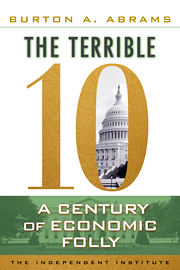With the U.S. unemployment rate still over 6 percent and the labor force participation rate at its lowest level since 1978, the Great Recession hardly seems a thing of the past. That calls for a look back at how it came about in the first place, and how another might be avoided.
According the National Bureau of Economic Research, the worst recession since the Great Depression officially started in December 2007. But its roots actually go back to the Community Reinvestment Act (CRA) of 1977.
The CRA sought to correct discrimination in the mortgage market by ensuring that all people, regardless of race or neighborhood of residence, would have equal access to bank loans. Few citizens would think this unreasonable, but the CRA also scored banks on their performance. This made increased subprime lending a virtual necessity for any bank looking to expand. This took on increased importance in 1994 when Washington opened the door to bank expansions across state lines.
Enter the Federal National Mortgage Association (Fannie Mae) and the Federal Home Mortgage Association (Freddie Mac). Fannie and Freddie’s federally mandated mission was to increase the flow of funds going into mortgages by buying mortgages originated by banks, enabling the banks to make more loans.
A 1992 law, the Federal Housing Enterprises Financial Safety and Soundness Act, established goals for Fannie and Freddie to purchase subprime mortgages from banks and other lenders.
From 1993 through 1995, 30 percent of the mortgages purchased were to be from low- and moderate-income households and 30 percent from “underserved” areas. The percentages were to rise yearly, and by 2006 the mandate was 53 percent from low- and moderate-income families, and 38 percent from underserved areas.
This provided an outlet for mortgage originators to make and unload risky mortgages, helping to fuel the housing bubble of 1997 to 2006. But all bubbles eventually break, and this one had disastrous consequences.
After a decade of increases, housing prices declined steadily. Foreclosures rose as people walked away from bad investments. Financial institutions that held mortgages suddenly found they were holding toxic assets.
On Oct. 9, 2007, 18 months after real-estate prices peaked, the Dow Jones Industrial Average began a torturous fall. While wealth dissolved, household debt didn’t, and many homeowners found their homes “under water,” worth less than the amount of their mortgage.
Many if not most of these homeowners were lower-income families, the very people federal policy aimed to help. In February 2011, 15.7 million homes, 27 percent of all single-family homes with mortgages, were under water.
Indeed, the Financial Crisis Inquiry Commission concluded that the financial crisis was caused in large part by failures in financial regulation and supervision.
All told the government’s role in contributing to excessive subprime lending, the housing bubble and the Great Recession must rank high among its worst public policies of the past hundred years.
Accordingly, Americans have every right to pose some tough questions.
Does the nation really need Fannie and Freddie to redirect credit in the economy? Should the Federal Reserve also have taken on that role with its mortgage-buying “quantitative-easing” program? Is it appropriate for government to set percentages of lending that should go to lower-income people? Should legislators and regulators be allowed to escape responsibility for an economic disaster that lingers to this day?
Legislators need to face the music and avoid the blunders of the past. If they make long overdue pro-growth reforms and abstain from misallocating credit in the financial markets, they may spare the nation another major recession.
Otherwise, the United States is likely to underperform economically for decades to comes, just like most of Europe, with slow growth and high unemployment.







